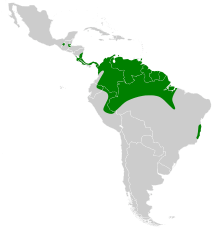Niceforo's big-eared bat
Niceforo's big-eared bat (Trinycteris nicefori) is a bat species from South and Central America, ranging from Chiapas to Bolivia and northeastern Brazil.[1] Its habitat is primary and secondary forest at altitudes from sea level to 1000 m.[1] It is crepuscular, being most active in the hour after sunset and before dawn.[1] The species is monotypic within its genus.[2]
| Niceforo's big-eared bat | |
|---|---|
 | |
| Scientific classification | |
| Kingdom: | Animalia |
| Phylum: | Chordata |
| Class: | Mammalia |
| Order: | Chiroptera |
| Family: | Phyllostomidae |
| Genus: | Trinycteris Sanborn, 1949 |
| Species: | T. nicefori |
| Binomial name | |
| Trinycteris nicefori Sanborn, 1949 | |
 | |
Description
It is a small species with triangular ears. Individuals weigh 7–11 g (0.25–0.39 oz) and have forearm lengths of 35–40 mm (1.4–1.6 in). Its fur is grayish-brown. Most individuals have a faint, pale-colored stripe that runs down their back along the spine. Its dental formula is 2.1.2.32.1.3.3 for a total of 34 teeth.[3]
Biology and ecology
It is nocturnal, roosting in sheltered places during the day such as hollow logs and human structures.[3]
Range and habitat
It is found in several countries in Central and South America. Its range includes: Belize, Bolivia, Brazil, Colombia Costa Rica, Ecuador, French Guiana, Guatemala, Guyana, Mexico, Nicaragua, Panama, Peru, Suriname, Trinidad and Tobago, and Venezuela. It is found at elevations up to 1,000 m (3,300 ft) above sea level.[1]
Conservation
As of 2015, it is classified as a least-concern species by the IUCN. It meets the criteria for this classification because it has a wide geographic range and is unlikely to be experiencing rapid population decline. Also, its range includes protected areas.[1]
References
- Tavares, V.; Burneo, S. (2015). "Trinycteris nicefori". IUCN Red List of Threatened Species. 2015: e.T13381A22123365. doi:10.2305/IUCN.UK.2015-4.RLTS.T13381A22123365.en.CS1 maint: uses authors parameter (link)
- Simmons, N.B. (2005). "Order Chiroptera". In Wilson, D.E.; Reeder, D.M (eds.). Mammal Species of the World: A Taxonomic and Geographic Reference (3rd ed.). Johns Hopkins University Press. p. 411. ISBN 978-0-8018-8221-0. OCLC 62265494.
- Escobedo, L.; León-Paniagua, Livia (2014). Ceballos, G. (ed.). Mammals of Mexico. JHU Press. p. 687. ISBN 1421408430.
